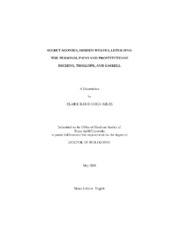| dc.description.abstract | This dissertation explores the ways in which Charles Dickens writes Nancy in Oliver Twist, Anthony Trollope writes Carry Brattle in The Vicar of Bullhampton, and Elizabeth Gaskell writes Esther in Mary Barton to represent and examine some very personal and painful anxiety. About Dickens and Trollope, I contend that they turn their experiences of shame into their prostitute's shame. For Gaskell, I assert that the experience she projects onto her prostitute is that of her own maternal grief in isolation. Further, I argue that these authors self-consciously create biographical parallels between themselves and their prostitutes with an eye to drawing conclusions about the results of their anxieties, both for their prostitutes and, by proxy, for themselves. In Chapter II, I assert that in Nancy, Dickens writes himself and his sense of shame at his degradation and exploitation in Warren's Blacking Factory. This shame resulted in a Dickens divided, split between his successful, public persona and his secret, mortifying shame. Both shame and its divisiveness he represents in a number of ways in Nancy. In Chapter III, I contend that Trollope laces Carry Brattle with some of his own biographical details from his early adult years in London. These parallels signify Carry's personal importance to her author, and reveal her silences and her subordinate role in the text as representative of Trollope's own understanding and fear of shame and its consequences: its silencing and paralyzing nature, and its inescapability. In Chapter IV, I posit that Gaskell identifies herself with Esther, and that through her, Gaskell explores three personal things: her sorrow over the loss of not one but three of her seven children, her possible guilt over these deaths, and her emotional isolation in her marriage as she grieved alone. In her creation of Esther, Gaskell creates a way both to isolate her grief and to forge a close companion to share it, thus enabling her to examine and work through grief. In Chapter V, I examine the preface of each novel and find that these, too, reflect each author's identification with and investment of anxiety in his or her particular prostitute. | en |


